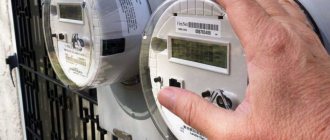How is electricity consumption paid without a meter?
Source: EnergoVOPROS. ru, 01.08.2018
https://energovopros.ru/issledovania/2322/2326/41611/
How to pay for electricity without a meter? In what cases should the consumer pay according to average consumption, and in what cases - according to the standard? In what cases is the fee charged according to the standard with an increasing factor? And how, after all, is it more profitable to pay for electricity - according to the meter or according to the standard? Visitors to EnergoVOPROS.ru often ask these kinds of questions. Let's try to figure it out.
Paying for electricity without a meter: what the current legislation says
Probably everyone knows how electricity charges are calculated if an electricity meter is installed and working properly in an apartment.
There is a counter. There is his testimony. Take the number of kilowatt-hours spent per month and multiply it by the current tariff in your region. You receive the amount you need to pay for electricity consumption. It's simple!
But how is electricity payment calculated without a meter? Current legislation reduces the variety of life situations to the following options:
- there is a meter, but its readings were not transmitted on time (in accordance with the established procedure)
- There is a meter, but it turned out to be faulty (it broke down, the verification period has expired)
- There is a meter, but representatives of the energy supply service provider are not allowed to see it
- there is a meter, but upon inspection it turned out that it was deliberately damaged (or electricity was connected past the meter)
- Finally, there is simply no counter. And this situation is by no means uncommon.
How the fee for electricity supply service is calculated in each of these cases is described in detail in the Rules for the provision of utility services.
This document was approved by Government Decree No. 354 of May 6, 2011 No. 354 “Providing utility services to owners and users of premises in apartment buildings and residential buildings.” Since then, numerous changes have been made to it. The current version of the Rules can be found, for example, here.
Following the Rules, let's look at the options listed above.
Payment for electricity if meter readings are not submitted on time
Start over. In order to be able to pay for electricity based on meter readings, you need to transfer these readings to the person who supplies you with electricity.
How to transmit meter readings? When? To whom? These questions are quite appropriate and deserve separate analysis. In short, the readings are transmitted either to the energy sales company (your electricity supplier), or to the management company of your home, or through a city (regional) settlement center.
There are also several other ways. But here and now it is important to note that if the meter readings are not transmitted, then you will not be able to pay for electricity using them. Looks fair.
So, if you have not provided meter readings, the electricity fee is determined based on your average monthly consumption.
“Average monthly” consumption in this case is calculated based on the readings you took (or they were obtained, for example, during a check of your meter) over the past six months.
The exception referred to in the Rules is in cases where payments on the meter began less than six months before the moment you did not transmit its readings. For example, the meter was delivered to you in June, but in October you did not provide the readings. In this case, your average monthly electricity consumption for the period of actual operation of the meter is taken as a basis. But not less than 3 months.
You didn’t submit your testimony for one month, the second, the third... What’s next? Starting from the fourth month, during which you do not submit meter readings, you will be transferred to payment according to the standards. See what it looks like here.
If you are interested in how the above is formulated in the Rules for the Provision of Public Utilities, then you need to study clause 59 (b) of this document.
Payment for electricity if the meter is (was) found to be faulty
Let's imagine: you somehow discovered that your meter is faulty. It was destroyed during repair work. Damaged in a fire. It just stopped working, and even you can see it. Alternatively, it was stolen. Either its verification period has expired, or its service life has expired... How is the payment for light calculated in this case?
The situation is described in paragraph 59 (a) of the Rules for the Provision of Public Utilities. First of all, the moment of occurrence of the “event” is determined, that is, when exactly the metering device is recognized as faulty (lost)?
This may be the date of your statement to the energy sales company about a faulty meter. Or the date of drawing up a report on the malfunction of the meter based on the results of its inspection by an inspector. Or the expiration date of the meter's verification interval. If there is no exact date, then the month (payment period) in which the “event” occurred is taken as the “reference point”.
From this date you will be transferred to payment based on average monthly consumption. Average monthly consumption is calculated in the same way as in the previous paragraph - based on the last six months.
However, “on average” you will only be paid for three months in a row. After which they will transfer to payments according to the standard. How the electricity fee is calculated according to the standard, see here.
It is worth noting that for some time now, consumers whose electricity meter has failed and who have been living without a meter for more than three months have been charged according to the standard with an increasing factor of 1.5. So it would be good to hurry up with the installation of a new meter.
Separately, it is worth considering the case when a malfunction of the meter is discovered during a meter inspection by a representative of an energy sales company, and the inspector insists that there was unauthorized interference in the operation of the meter. The list of signs of such interference is given in clause 81.11 of the Rules.
Violations must be described in a special Act. From the date of its signing, electricity consumption is recalculated based on the standard increased by 10 times (pro-standard, again see the link).
The recalculation period is three months preceding the date of detection of the violation and until the date of their elimination (which in most cases means replacing the meter).
There is a meter, but representatives of the energy sales company are not allowed to see it. How are electricity charges calculated?
First, let's define what does “not allowed” mean? Often, electricity meters are installed directly in the apartment or in the vestibule, access to which from the landing is closed with a “good iron door” (c).
That is, it is not so easy for an outsider to get into the meter. At the same time, energy sales inspectors have a habit of visiting subscribers during working hours. They do not travel at night or early in the morning. This means that they have little chance of crossing paths with the apartment’s inhabitants.
Just for such a case, the Rules for the Provision of Utility Services detail the procedure that the energy sales representative must follow in order to agree on the inspection time with the apartment owner.
Representatives of the electricity supplier organization are required to notify the owners of the apartment being inspected in advance. Those, in turn, must confirm that they will be at home at the proposed time.
They don't confirm? This means that the utility service provider is obliged to send a second notification. If it is not possible to agree on a date for the visit the second time (or the inspectors came at the agreed time, but there is still no one at home), then a special document is drawn up - an Act on the refusal of the contractor’s access to the metering devices.
Each iteration of this complex procedure is described in detail in paragraph 85 of the Rules. If you really need to know exactly who should do what and in what order? - be sure to read it.
From the date when the Certificate of Denial of Admission is issued, the consumer is transferred to payment based on average monthly consumption. If the issue with checking the meter is not resolved within three months, then you will begin to receive payments for electricity, calculated according to the standard.
How is the payment for electricity calculated if the meter is deliberately damaged, or (as an option) electricity goes to the apartment, bypassing the meter?
It was already written about a little higher. This situation is the most unpleasant for the consumer. The method of payment for electricity in such circumstances is described in clause 62 of the Rules for the provision of utility services.
So, during the inspection, the inspectors discovered that your electric meter was deliberately put in a faulty state and counts the electricity in “your favor”, or the electricity in your apartment (house) was supplied past the meter. What will happen next? The consequences are quite severe.
Utilities have the right to charge additional charges for electricity based on the total number of electricity consumers in an apartment (private house) and the maximum power they consume. The calculation is made based on the fact that electricity consumption occurs around the clock. And the additional charges themselves are made for three months preceding the elimination of an unauthorized connection past the meter.
If it is impossible to determine which electricity consumers are in the apartment and what their maximum power is, then the payment for electricity in this case is calculated based on a standard increased tenfold.
Read about the standard below; here it is worth noting that the amounts accrued in this way are several times, or even an order of magnitude, higher than the fee for actual electricity consumption.
As in the case of calculations based on maximum power, recalculation according to a 10-fold increased standard is made three months prior to the removal of the connection to the electrical networks past the meter.
A small clarification - if inspectors visited you less than three months before the violation was discovered and nothing “criminal” was found, then the calculation of electricity charges based on the maximum possible consumption (or 10 times the standard) will be made from the date of this visit.
How to pay for electricity if your apartment does not have a meter? And/or never happened? Those. according to the standard?
Electricity meters are, of course, not water meters, which began to be installed en masse only in the last decade.
It was mandatory to equip apartments with electricity meters back in Soviet times. And yet, many apartments (one of the most common cases are apartments in former dormitories) and private houses still do not have meters. Payment for electricity in this case is calculated according to the standard.
The standard in this case is the calculated value of electricity consumption in a residential premises, which is tied to the number of rooms in the apartment and the type of its amenities (gas stove or electric).
In the Rules for the Provision of Utility Services, the issue of payment for electricity according to the standard is dealt with in paragraph 42. Let's go through it.
So, three indicators are taken:
- number of citizens permanently or temporarily residing in residential premises
- electricity consumption standard, it is determined for each region by a separate decision of local authorities
- electricity tariff valid for this type of consumer
These three figures are multiplied and the cost of electricity is obtained, which is indicated on the payment invoice.
To this it is worth adding the following:
First: if no one is officially registered in the apartment (either permanently or temporarily), then the standard fee is calculated based on the number of homeowners
Second: the authorities strongly want electricity meters to be installed in all houses and apartments, so if the residential premises are not equipped with an electricity meter, then the standard fee is charged with a coefficient of 1.5 (without a coefficient, the standard fee is charged in cases where the meter is there is, but his readings are not transmitted).
What is more profitable: according to the meter or according to the standard?
People often ask: what is the best way to pay for electricity? According to the standard or, nevertheless, according to the meter, without spending money on its purchase and installation?
Generally speaking, the answer would be:
- if more people actually live in the apartment than officially registered, then paying according to the standard may be more profitable,
- and if, on the contrary, more people are registered than live, then, of course, it will be cheaper to pay for electricity using the meter.
Well, if you are interested in specifics, you need to look for a decision from the tariff authority of your region, which approved consumption standards. Next, arm yourself with a calculator and count.
But still, we would venture to assume that in most cases it will still be more profitable to install a meter.
In connection with numerous requests from citizens living in apartment buildings, where a direct management method has been chosen or a management method has not been chosen, on the issues of high charges for electrical energy consumed in the maintenance of common property, EC “Vostok” explains.
According to the law, apartment owners living in multi-apartment buildings, where the management method is direct management or the management method is not selected, are charged for electricity consumed during the maintenance of common property by EC "Vostok".
When calculating, it is taken into account that as of July 1, 2020, paragraph. 2 clause 44 of Rules No. 354, according to which the volume of utility services provided for general house needs distributed among consumers during the billing period could not exceed the volume of utility services calculated on the basis of consumption standards for utility services provided for general house needs.
Thus, from 07/01/2020, the volume of electrical energy used for general house needs is determined as the difference in electricity consumption in accordance with the data of the common house metering device and the consumption of all individual metering devices of consumers who have these devices installed, the electricity consumption standards of consumers who have there are no metering devices, the average monthly consumption of the owners, in case they do not transmit meter readings, as well as the consumption of all non-residential premises (shops, etc., if available in the apartment building). The resulting actual volume of consumption of utilities for general house needs is distributed among all owners of premises in an apartment building without taking into account any standards in proportion to their share in the right of common shared ownership of common property in an apartment building.
Energosbytovaya makes all charges within the framework of current legislation in accordance with established rules and regulations.
In most cases, the reasons for high charges for electricity consumed for the maintenance of common property in apartment buildings, in the presence of common building metering devices, are the following: untimely transmission by consumers of readings from individual metering devices (since real consumption may be higher than the average or according to the standard) and theft of electrical energy by unscrupulous owners. Thus, the solution to the issue of high charges for the maintenance of common property can be: organization by residents of a monthly timely transmission of readings from all individual and common building meters installed in an apartment building no later than the 25th day of each month and reporting to JSC EC Vostok about any unauthorized connections, facts of unmetered electricity consumption to eliminate illegal connections.
It is also necessary to take into account that the payment for utilities consumed during the use of common property in an apartment building is not only a payment for lighting in the entrances. This also includes fees for lighting attic and basement spaces, for the operation of fire alarm systems, intercoms - all electrical equipment that is the common property of all residents. In addition, technological losses in intra-house networks are also paid for as maintenance of common property.
Payment for electricity for an apartment in shared ownership with one common meter
Payment for electricity for an apartment in shared ownership with one common meter
Decree of the Government of the Russian Federation dated 05/06/2011 N 354 (as amended on 09/04/2015) “On the provision of utility services to owners and users of premises in apartment buildings and residential buildings” (together with the “Rules for the provision of utility services to owners and users of premises in apartment buildings and residential buildings houses")
Clause 50. Calculation of the amount of payment for utility services provided to a consumer living in a room (rooms) in a residential premises that is a communal apartment (hereinafter referred to as a communal apartment) is carried out in accordance with formulas 7.....
If a communal apartment is equipped with a common (apartment) electricity meter and not all rooms in the communal apartment are equipped with room electricity meters, then the calculation of the amount of payment for the utility service for electricity provided to the consumer living in the room (rooms) equipped with a room electrical energy metering device, is carried out based on the readings of the room metering device and the agreement reached between all consumers in a communal apartment on the procedure for determining the volume (quantity) of electrical energy consumed in the premises, which are the common property of the owners of rooms in a communal apartment, and on its distribution among all consumers in a communal apartment.
This agreement must be in writing, signed by the consumers of the communal apartment or their authorized representatives and handed over to the contractor. In this case, the contractor calculates the payment for utility services for electricity provided to consumers in a communal apartment in accordance with the agreement received from them, starting from the month following the month in which such an agreement was transferred to the contractor.
In the absence of the specified agreement, the calculation of fees for utility services for electricity supply is carried out in accordance with formula 7 of Appendix No. 2 to these Rules without taking into account the readings of room electricity meters.
Calculation of the amount of payment for utility services,
provided to the consumer for the billing period
in the j-th room(s) he occupies
in the i-th communal apartment
Very often, energy sales companies talk about the joint liability of all owners of a divided apartment with several shared owners for paying for electricity, but THIS IS NOT SO (we present practice on this issue):
By virtue of paragraph 1 of Art. 322 of the Civil Code of the Russian Federation, a joint obligation (liability) or a joint claim arises if the solidarity of the duty or claim is provided for by an agreement or established by law, in particular when the subject of the obligation is indivisible.
Since the obligation to pay for consumed electricity is monetary, there is no sign of indivisibility of the subject of the obligation.
Part 3 of Art. 31 and part 2 of Art. 69 of the Housing Code of the Russian Federation provides for joint liability for obligations arising from the use of residential premises, respectively, for family members of the owner of residential premises (responsible jointly with the owners) and for family members of the tenant (responsible jointly with him).
In turn, other norms of legislation regulating the procedure for the provision and payment of utility services, as well as services for the maintenance and repair of residential premises, indicate that the obligations of tenants and owners of premises in a communal apartment to pay for such services are subject to fulfillment in shares, and not jointly and severally , and stipulate how exactly the relevant shares should be determined.
So, according to part 2 of Art. 43 of the Housing Code of the Russian Federation, the share of mandatory expenses for the maintenance of common property in a communal apartment, the burden of which is borne by the owner of a room in this apartment, is determined by the share in the right of common ownership of the common property in this apartment of the specified owner.
The same principle applies when distributing responsibilities for paying utility bills between the owners and tenants of residential premises in a communal apartment, which follows, in particular, from the “Rules for the provision of utility services to owners and users of premises in apartment buildings and residential buildings”, approved by the Decree of the Government of the Russian Federation Federation dated 05/06/2011 N 354.
Sincerely, founder of the ENERGOSCHET project, Candidate of Legal Sciences Yuriy Petrovich Garkavy
Electricity in a communal apartment: how not to pay for a neighbor and avoid debts for electricity?
10.09.2016
Light / Electricity in a communal apartment
Mikhail Kozyrev
A communal apartment is not the best option for living. And if possible, it is better to exchange a room in a communal apartment for a small, albeit in a worse area, but a separate apartment. Unfortunately, this possibility is not always available. Then you have to live in a communal apartment and try to improve relations with your neighbors.
One of the pressing problems is how to pay for utilities? And if for most of the consumed resources (water, gas, heat, garbage removal) the residents - owners (tenants) of rooms in a communal apartment each pay through their own personal account, then in many cases the situation with paying for electricity is dire.
What if one of your neighbors in a communal apartment does not pay for electricity and the debt increases, which is distributed among all residents? Let's figure it out together.
Electricity in a communal apartment. What does the legislation say?
The issue of payment for electricity in a communal apartment, as well as most issues related to payment for housing and communal services, are explained in the “Rules for the provision of utility services to owners and users of premises in apartment buildings and residential buildings” (hereinafter referred to as the Rules), approved by a decree of the Government of the Russian Federation of May 6 2011 N 354.
In total, the Rules provide for four options for paying for electricity in a communal apartment.
Option 1. A communal (apartment) meter and room electricity meters are installed in a communal apartment. In this case, consumption for each room is calculated as the sum of the room meter readings plus the room's share of electricity consumption in common areas. This share is calculated as follows:
- The sum of the readings of all room meters is subtracted from the total consumption of the apartment
- those receiving readings are divided in proportion to the number of people officially living in the room.
Option 2. A communal apartment has a common meter; room meters are not installed in all rooms. At the same time, the owners (tenants) of individual rooms entered into a written agreement on how electricity costs will be distributed in common areas. This agreement must be signed by the owners (tenants) of all rooms (or their legal representatives) and submitted to the energy supply company.
In this case, the owner of the room with a meter pays for electricity consumption based on the readings of his meter, plus his share (in accordance with the agreement) of consumption in common areas.
Option 3. A common meter is installed in a communal apartment, room meters are not installed (or not installed in all rooms), there is no agreement between residents on methods of paying for light in common areas.
In this case, the payment for light for the owners of each room is calculated in proportion to the ratio of the number of residents in a given room to the total number of officially residents.
Option 4. The communal apartment does not have a common (apartment) meter (or it is considered faulty). In this case, the total electricity consumption in the apartment is calculated based on the standards. The standards (i.e. the estimated amount of electricity consumption) depend on several factors:
- number of residents in the apartment
- number of rooms in the apartment
- type of improvement of the house in which the apartment is located (electric or gas stoves)
The total electricity consumption of the apartment, calculated in this way, is distributed among the owners (tenants) of the rooms in proportion to the number of persons officially living in them (rooms).
This is the normative basis. You can read the text of the Rules themselves at this link. You will need item 50.
And now about the problems that arise with paying for electricity and the possibilities of solving them.
The main problem is the “joint and several” responsibility of neighbors for debts for light in a communal apartment
So, the main problem looks like this: one or more room owners do not pay for the light. The debts grow and grow, turning in five years into a really serious amount, thirty, forty, or even fifty thousand rubles.
The energy supply organization (in Moscow, for example, it is Mosenergosbyt) demands payment of this debt. Moreover, this requirement is imposed on all residents of a communal apartment. And even if one of the owners of the room, as it seems to them, paid for “their” part of the electricity, the requirement to pay the total debt is distributed to all residents.
This is followed by a trial, power outage, and forced collection of debt. In the end, those residents who already paid their debts for electricity pay off their debts. And the answer to all objections of conscientious payers is that the owners (tenants) of individual rooms in the apartment must resolve settlement issues among themselves independently. Like, sue your neighbors and get money from them according to a court decision. So how can you get money from a person who doesn’t have a permanent job or other sources of income? No way. Energosbyt thus simply shifts its problems onto the shoulders of conscientious payers.
However, what opportunities are there (and are there any?) to avoid joint liability for debt from past periods is a separate sore subject. First, it’s worth figuring out what you can do so as not to pay for your neighbors, but only for yourself.
How not to pay for your neighbor’s electricity in a communal apartment: the Formula 7 method
The first way to solve the problem is the most obvious. As we indicated above, in the analysis of the “Rules for the provision of public utility services” in the part relating to electricity in a communal apartment, the Rules quite clearly state that if the apartment has a common meter, but the rooms do not have them, then the payment for electricity should be carried out as follows:
- meter readings in the apartment are taken
- divided between rooms in proportion to the number of residents officially registered in them
This mechanism is described by Formula 7 in Appendix 2 of the “Rules for the Provision of Public Utilities” (Resolution No. 354).
It seemed like the most clear and simple option. There is no need to install separate meters in rooms. There is no need to enter into any interactions with neighbors. However, there are also pitfalls here.
First of all, it is worth noting that the distribution of electricity charges between rooms will be made not according to actual consumption, and not based on the number of actual residents, but according to the number of persons officially “registered” in the room.
In other words, if one person is registered in a room, but there are actually four people living in it, then this room will pay for one. And vice versa - if four are registered, but one person lives, then the calculation will be made for four.
At the same time, for your room, you can, of course, provide the electricity supplier with data on the number of actual occupants. With neighbors' rooms, the issue cannot be resolved so easily.
But that's not the main thing. More importantly, energy supply companies are not always eager to switch to this form of interaction.
For example, in St. Petersburg, where the largest number of communal apartments in the Russian Federation, after numerous complaints and demands from citizens, the local Petroelectroesbyt has for some time now begun to accept applications for separate electricity metering in communal apartments. And they transfer to this account.
Here, for example, is a receipt with separate electricity metering that arrived at one of the St. Petersburg utilities in August 2016.
And this is an application form for a separate payment for electricity in a communal apartment, which is issued by Petroelectrosbyt.
More information on how to force Petroelectrosbyt to switch to separate payment for electricity in a communal apartment can be obtained in the VKontakte social network community called “Petroelectrosbyt and Utilities”, address - https://vk.com/club72197349
In Moscow, where a large number of communal apartments also remain, the situation is still different. Mosenergsbyt does not meet the needs of residents of communal apartments who demand that electricity calculations be organized according to Formula 7.
The position of the energy sales company, as far as it can be understood from the responses to customer requests, boils down to the fact that since a communal apartment has a common personal account, then the residents must pay for electricity jointly. And how the residents of the “communal apartment” sort things out within themselves is no longer the business of Mosenergosbyt.
Such answers naturally cause dissatisfaction among residents. They file claims in courts and other authorities. The results of these appeals are mixed. A significant number of decisions were made in favor of Mosenergosbyt and the principle of joint liability of residents. Here, at the link, is a typical court decision on this situation - https://docs.pravo.ru/document/view/25584911/
However, there are also opposite solutions. For example, such a decision was made by the Moscow Arbitration Court, which considered the case of Mosenergosbyt against the Antiponopoly Directorate for Moscow.
In short, the plot is that a Muscovite, dissatisfied with the application of the principle of joint responsibility for paying for electricity in a communal apartment, applied to the FAS Moscow department with a demand to ensure that he is able to pay only for personal electricity consumption. The FAS granted this application and ordered Mosenergosbyt to transfer the applicant to pay for electricity according to Formula 7. Energy workers tried to challenge this decision in court. But unsuccessfully. Link to the court decision: https://kad.arbitr.ru/PdfDocument/d623c3f9-669e-4fbc-8452-955843652e77/A40-170884-2015_20151228_Reshenija%20i%20postanovlenija.pdf
In general, if we talk about the situation as a whole, in Moscow it is currently difficult to achieve separate payment for electricity for rooms in a communal apartment according to Formula 7 from Appendix 2 of the Rules for the Provision of Utilities; in fact, people do not agree to such a scheme.
There are chances of getting your way in court, but they are slim. More information on the situation can be found, for example, in the same VKontakte group, whose members are seeking separate electricity metering in a communal apartment. There is also a “Moscow faction” - https://vk.com/topic-72197349_34554992
How not to pay for electricity for a neighbor in a communal apartment: a method of separate accounting by room
The second way to solve the problem of payment in the “communal apartment” is to provide separate accounting in separate rooms of the apartment. In other words, in addition to the general apartment meter, install meters in each of the rooms. This option, as you remember, is also provided for by the “Rules for the provision of public utilities”.
The main advantage is that, unlike the Formula 7 option, room meters make it possible to actually pay for your consumption (regardless of the number of registered ones).
The main disadvantage is that the meters become “real”, i.e. calculated, they must be officially installed and sealed by Mosenergosbyt. At the same time, energy workers must be sure that you have no consumption “before the meter”. That is, the wiring in the apartment will most likely have to be redone. And not just like that, but with the receipt of an official document from the management organization as a result of the “reconstruction”, describing the apartment electrical network diagram (most likely it will be a single-line diagram).
You must also take into account that the meter will need to be installed not only in your room, but also in all the others. Only if there is a meter in all rooms, the electricity supplier will be able to transfer your electricity payment according to their readings.
At the same time, general consumption will remain (hallways, kitchen, baths, toilets). Let us remember that it is distributed either by agreement between residents or in proportion to the number of registered residents. And there is no guarantee that one of the non-paying neighbors will not connect to the outlet in the corridor (another common area) if his room, equipped with an electricity meter, is not turned off for debts.
There is, of course, a way to avoid this danger. For example, all “common” electricity consumers (light bulbs in the kitchen, toilet, bathroom, sockets in the hallway, etc.) can be duplicated for each of the owners. Power them through room meters. And make a separate switch inside the room for each consumer.
In other words, you go to the kitchen - turn on the required switch in your room and it is your lamp in the kitchen that lights up (one of, say, three, according to the number of neighbors). Electricity consumption in this case is taken into account by your room meters; there is no separate electricity for common areas at all.
But this option is bad because wiring and duplicating lighting sources will be expensive. The consent and participation of neighbors in this process will be required. Also, approval is required from the management organization of your home. The path is, of course, long, but in principle, surmountable.
I would, of course, advise you to follow it. But the main obstacle is the neighbors!
If disagreements with them are, as they say, “principled” in nature, you simply have a VERY BAD relationship with them, you wouldn’t even look at them. But they still pay for utilities. They have money for this. And once you still can agree on how to pay. Well, in this case, the option with separate metering of electricity in common areas will suit you.
Or perhaps a simpler option would be suitable - with a meter in each room and a written agreement on the proportions in which “general” electricity will be paid.
It is much worse if the next room is inhabited by what are called dysfunctional tenants. They do not pay for housing and communal services and do not intend to pay. And even if you do all the wiring for them, install meters and even arrange for seals to be installed on them, the neighbors still won’t pay... Their debt will increase. He will not be paid either. As a result, the neighbors' electricity will be cut off. They will connect to another “in-house” line. And everything will start from the beginning...
Fair payment for electricity in a communal apartment - summary
And what is the general summary? Alas, once again, a communal apartment is not the best place to live. If your neighbors are, in principle, negotiable and willing to pay for electricity, then it is possible to find a formula for coexistence. And even formalize it (in case of possible future friction).
Well, if you and your neighbors are completely unlucky... Try fighting for Formula 7. The experience of St. Petersburg, where residents of communal apartments finally achieved separate bills for rooms, suggests that this is, in principle, possible.
This path will most likely not be easy. And the payment is not entirely fair (based on the number of registered, not actual consumption). But at least you won't be forced to pay astronomical electricity bills in a few years that have grown out of your neighbors' debts.
Electricity tariffs in the Moscow region from January 1, 2021
- 30.03.2021
Electricity tariffs in the Moscow region. Valid from January 1, 2021 | ||||
| The tariffs (prices) below for electricity in the Moscow region are valid from January 1, 2021 to June 30, 2021. | ||||
What is your electricity tariff? | ||||
| First of all, you need to decide which group of electricity consumers you belong to, and what tariff you need to look at. | ||||
| Firstly, electricity tariffs for the population are set depending on the type of settlement (urban or rural). | ||||
| Secondly, tariffs for urban residents vary depending on whether you have a gas stove or an electric one (electric heating devices). It is worth considering that the electric stove (heating appliances) must be installed officially, in accordance with the design documents for your home. | ||||
| Third, electricity tariffs can be calculated based on different rates at different times of the day. Most of us pay the so-called single-rate tariff, in which the cost of 1 kilowatt/hour does not depend on the time of day. However, an increasing number of people are switching to a two-zone (day-night) or even a three-zone tariff. In this case, electricity will cost you less at night and more during the day. | ||||
Electricity tariffs for the population living in urban settlements of the Moscow region in houses equipped with gas stoves | ||||
| One-rate tariff for electricity | 5.73 | RUR per 1 kWh | ||
| Electricity tariff differentiated by two zones of the day | ||||
| day zone (from 7 to 23 hours) | 6.59 | RUR per 1 kWh | ||
| night zone (from 23 to 7 o'clock) | 2.52 | RUR per 1 kWh | ||
| Electricity tariff differentiated by three zones of the day | ||||
| peak zone (from 7 to 10 and from 17 to 21 hours) | 7.45 | RUR per 1 kWh | ||
| half-peak zone (from 10 to 17 and from 21 to 23 hours) | 5.73 | RUR per 1 kWh | ||
| night zone (from 23 to 7 o'clock) | 2.52 | RUR per 1 kWh | ||
Electricity tariffs for the population living in urban settlements of the Moscow region in houses equipped in the prescribed manner with electric stoves and (or) electric heating devices | ||||
| One-rate tariff for electricity | 4.01 | RUR per 1 kWh | ||
| Electricity tariff differentiated by two zones of the day | ||||
| day zone (from 7 to 23 hours) | 4.61 | RUR per 1 kWh | ||
| night zone (from 23 to 7 o'clock) | 1.76 | RUR per 1 kWh | ||
| Electricity tariff differentiated by three zones of the day | ||||
| peak zone (from 7 to 10 and from 17 to 21 hours) | 5.21 | RUR per 1 kWh | ||
| half-peak zone (from 10 to 17 and from 21 to 23 hours) | 4.01 | RUR per 1 kWh | ||
| night zone (from 23 to 7 o'clock) | 1.76 | RUR per 1 kWh | ||
Electricity tariffs for the population of the Moscow region living in rural areas | ||||
| One-rate tariff for electricity | 4.01 | RUR per 1 kWh | ||
| Electricity tariff differentiated by two zones of the day | ||||
| day zone (from 7 to 23 hours) | 4.61 | RUR per 1 kWh | ||
| night zone (from 23 to 7 o'clock) | 1.76 | RUR per 1 kWh | ||
| Electricity tariff differentiated by three zones of the day | ||||
| peak zone (from 7 to 10 and from 17 to 21 hours) | 5.21 | RUR per 1 kWh | ||
| half-peak zone (from 10 to 17 and from 21 to 23 hours) | 4.01 | RUR per 1 kWh | ||
| night zone (from 23 to 7 o'clock) | 1.76 | RUR per 1 kWh | ||
Electricity tariffs for consumers of the Moscow region equal to the population | ||||
| The electricity tariffs approved for the population of the Moscow region also apply to several other groups of consumers. Their list is given below. | ||||
| You can look at the cost of electricity for different categories of consumers equated to the population in the documents that set electricity tariffs in the Moscow region from January 1, 2021 to June 30, 2021 and which are shown at the bottom of the page. | ||||
Which groups of electricity consumers are considered equal to the population? | ||||
| 1. | populated areas, combined household buildings of citizens (cellars, sheds and other structures), residential areas at military units and correctional labor institutions, calculated using a common meter at the entrance; | |||
| 2. | providers of public utility services (homeowners' associations, housing construction cooperatives, housing and other specialized consumer cooperatives, management organizations or individual entrepreneurs managing an apartment building, housing organizations) purchasing electrical energy for the purpose of providing residential premises to owners and tenants in an apartment building and owners of residential buildings utility services for electricity supply, use for general house needs (lighting and other maintenance using electrical energy of inter-apartment landings, stairs, corridors, operation of elevators, pumps and other common property in residential buildings and dormitories) | |||
| 3. | horticultural, gardening or dacha non-profit associations of citizens - non-profit organizations established by citizens on a voluntary basis to assist its members in solving general social and economic problems of gardening, horticulture and dacha farming; | |||
| 4. | non-profit associations of citizens (garage construction, garage cooperatives, parking lots); | |||
| 5. | religious organizations maintained at the expense of parishioners. | |||
Electricity tariffs for other groups of electricity consumers | ||||
| Electricity tariffs for others, in addition to the population and equivalent categories of consumers, are established based on the results of market trading. Unregulated electricity prices set for your region can be viewed on the website of the last resort electricity supplier in your region. | ||||
| For categories of consumers other than the population, electricity tariffs may be differentiated depending on the voltage level, time of day, and metering of power consumption. | ||||
| Electricity tariffs, depending on the voltage level, are divided into tariffs for consumers: | ||||
| high voltage (HV) - 110 kV and above | ||||
| average first voltage (CH-I) - 35 kV | ||||
| average second voltage (CH II) - 20-1 kV | ||||
| low voltage (LV) - 0.4 kV and below. | ||||
| Electricity charges can be calculated based on: | ||||
| electricity tariff rates | ||||
| power tariff rates | ||||
| In addition, the electricity tariff may vary depending on how fully the consumer uses the power allocated to him (the so-called number of hours of use of the declared power). | ||||
Electricity tariffs for the population in the Moscow region are established by the following documents: | ||||
| Order of the Committee on Prices and Tariffs of the Moscow Region dated December 16, 2020 No. 256-R “On setting prices (tariffs) for electrical energy for the population and equivalent categories of consumers in the Moscow Region for 2021” | ||||
The body approving electricity tariffs in the Moscow region: | ||||
| Committee on Prices and Tariffs of the Moscow Region | ||||
Previous articleNext article









